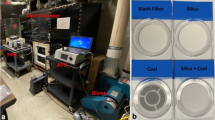Abstract
To facilitate the prediction and early warning of coal dust explosions in mines, a real-time online detection system that employs photoelectric diodes as light sources and narrow beam transmission technology based on the extinction statistical method is proposed. The study establishes a coal dust test model using the extinction statistical method, derives the extinction statistical test equations, and numerically analyzes the relationship between the average and standard deviation of transmittance using beams of varying thicknesses based on the theory of light transmission. The experimental devices of the test system and signal acquisition circuit are designed, and the interference of the original background light measure and light signal in the test is eliminated by prism splitting. Subsequently, coal dust measurement experiments are conducted using beams of diameters 0.05, 0.24, 0.72, and 1 mm. The experimental results indicate that selecting an appropriate beam thickness can enhance the accuracy of coal dust testing. The proposed system is capable of real-time online detection of coal dust particle size and concentration, demonstrating the practicality and feasibility of the system.





Similar content being viewed by others
Change history
07 November 2023
An Erratum to this paper has been published: https://doi.org/10.3103/S0146411623050139
REFERENCES
Wei, M., Tong, M., Hao, J., Cai, L., and Xu, J., Detection of coal dust in a mine using optical tomography, Int. J. Min. Sci. Technol., 2012, vol. 22, no. 4, pp. 523–527. https://doi.org/10.1016/j.ijmst.2012.01.014
Wang, Z., Zheng, X., Pan, H., and Li, D., Information entropy multi-decision attribute reduction fuzzy rough set for dust particulate imagery characteristic extraction, IEEE Access, 2020, vol. 8, no. 8, pp. 77865–77874. https://doi.org/10.1109/access.2020.2989831
Yu, H., Cheng, W., Wang, H., Peng, H., and Xie, Ya., Formation mechanisms of a dust-removal air curtain in a fully-mechanized excavation face and an analysis of its dust-removal performances based on CFD and DEM, Adv. Powder Technol., 2017, vol. 28, no. 11, pp. 2830–2847. https://doi.org/10.1016/j.apt.2017.08.010
Miller, A.L., Weakley, A.T., Griffiths, P.R., Cauda, E.G., and Bayman, S., Direct-on-filter α-quartz estimation in respirable coal mine dust using transmission Fourier transform infrared spectrometry and partial least squares regression, Appl. Spectrosc., 2017, vol. 5, no. 71, pp. 1014–1024.
Zhang, R., Liu, S., and Zheng, S., Characterization of nano-to-micron sized respirable coal dust: Particle surface alteration and the health impact, J. Hazard. Mater., 2021, vol. 413, no. 413, p. 125447. https://doi.org/10.1016/j.jhazmat.2021.125447
Liu, Y. and Heng, M.A., Remote on-line detection system for coal dust particle based on machine vision technology, J. Liaoning Tech. Univ. (Nat. Sci.), 2012, vol. 31, pp. 822–825.
Li-Xiu, M., Bo-Xue, T., Jing, J., and Xue-Ling, L., Pulverized coal fineness detection based on double-D optical sensor, China Coal Soc., 2012, vol. 37, no. 8, pp. 1369–1372.
Yuan, C. and Hui-Min, R., The denoising of acoustic emission signal in coal mine, Int. Symp. on Coal Gas Control Technology, 2008, pp. 319–322.
Wang, H., Jia, J., Yang, Yu., Buschle, B., and Lucquiaud, M., Quantification of gas distribution and void fraction in packed bubble column using electrical resistance tomography, IEEE Sens. J., 2018, vol. 18, no. 21, pp. 8963–8970. https://doi.org/10.1109/jsen.2018.2868463
Qin, Sh. and Cai, X., Indirect measurement of the intensity of incident light by the light transmission fluctuation method, Opt. Lett., 2011, vol. 36, no. 20, p. 4068. https://doi.org/10.1364/ol.36.004068
Gregory, J., Turbidity fluctuations in flowing suspensions, J. Colloid Interface Sci., 1985, vol. 105, no. 2, pp. 357–371. https://doi.org/10.1016/0021-9797(85)90309-1
Singh, P. and Bose, S.S., Ambiguous D-means fusion clustering algorithm based on ambiguous set theory: Special application in clustering of CT scan images of COVID-19, Knowl.-Based Syst., 2021, vol. 231, p. 107432. https://doi.org/10.1016/j.knosys.2021.107432
Singh, P. and Bose, S.S., A quantum-clustering optimization method for COVID-19 CT scan image segmentation, Expert Syst. Appl., 2021, vol. 185, p. 115637. https://doi.org/10.1016/j.eswa.2021.115637
Funding
This work was supported by the Key Research and Development Plan of Xuzhou (KC22083).
Author information
Authors and Affiliations
Corresponding author
Ethics declarations
The authors declare that they have no conflicts of interest.
Additional information
The original online version of this article was revised: Modifications have been made to the Affiliations. Full information regarding the corrections made can be found in the erratum/correction for this article.
About this article
Cite this article
Bencheng Yu, Zihui, R. & Shoufeng, T. A Novel Coal Mine Dust Measurement System and Experimental Analysis. Aut. Control Comp. Sci. 57, 348–354 (2023). https://doi.org/10.3103/S0146411623040107
Received:
Revised:
Accepted:
Published:
Issue Date:
DOI: https://doi.org/10.3103/S0146411623040107




